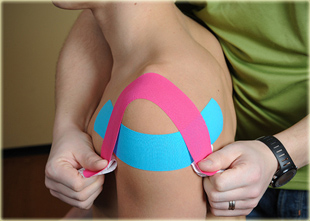Kinesiotaping was developed in the 1970s by a japanese chiropractionist Kenzo Kase when he noticed that moving the skin affects to joints movements and how the pain is felt. The method spread to North America and Europe in the late 1990 after the olympicgames in Soul. With the improvement of tapingtechniques the method is nowadays used in various physiotherapy areas, including scartreatment, lymphatic problems and pediatry. In the athletics and sports sector the users of kinesiotaping include among others Tiger Woods, Carolina Kluft, David Beckham, Serena Williams and Lance Armstrong.
The most usual usage of kinesiotaping is to decrease pain and to increase mobility and musclepower. The method may also be used to support the body's own healingprocess via blood and lymphatic circulation and also via neurophysiological factors.
With tape you can also increase the mobility of joints and guide the joint to function in a mechanically correct way or bring necessary support to the joint by using tight tape or by putting several layers of tape. Kinesiotaping may be considered more like sensory when the traditional sporttapings principle is more mechanic by nature.
The tape usage is much less in comparison to the traditional sporttaping. The benefits of kinesiotaping are ex. wide usability, good price-influence ratio, speed of usage and ease of use. The influnece depends on the taping technique used.
The most usual usage of kinesiotaping is to decrease pain and to increase mobility and musclepower. The method may also be used to support the body's own healingprocess via blood and lymphatic circulation and also via neurophysiological factors.
With tape you can also increase the mobility of joints and guide the joint to function in a mechanically correct way or bring necessary support to the joint by using tight tape or by putting several layers of tape. Kinesiotaping may be considered more like sensory when the traditional sporttapings principle is more mechanic by nature.
The tape usage is much less in comparison to the traditional sporttaping. The benefits of kinesiotaping are ex. wide usability, good price-influence ratio, speed of usage and ease of use. The influnece depends on the taping technique used.
Some theoretical effects kinesiotaping has:

- Pain degreases
- Mobility increases
- Musclepower increases
- Decreased blood circulation and lymphatic circulation improves
- Scartissue softens
- Jointmechanics improves and you learn proper movementmodel
- Increased joint support
- Muscletonus is normalized